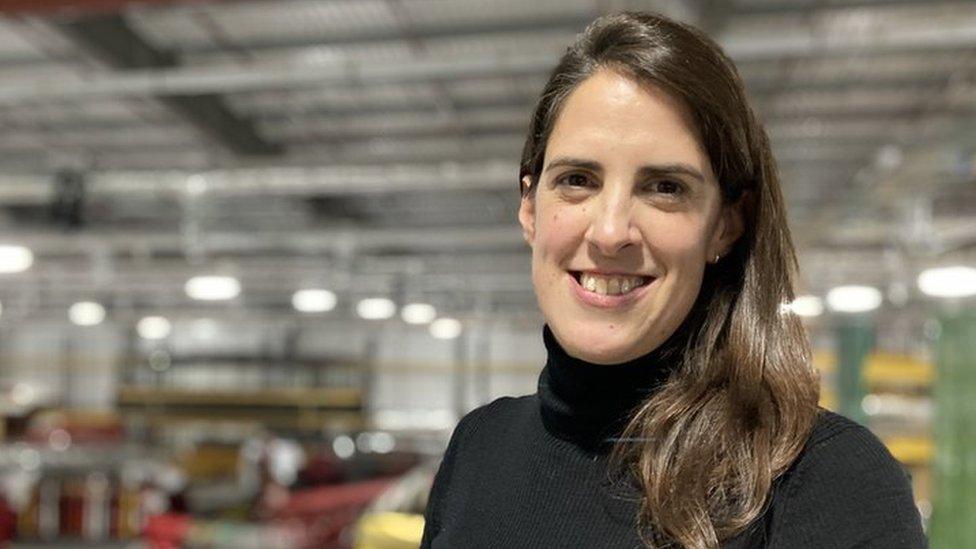Museum's move to Wiltshire like 'game of battleships'
- Published

The ground floor of the huge storage building holds the biggest objects
When it was announced that more than 300,000 objects would be moved by the Science Museum Group in west London to a storage unit near Swindon, it was described as the world's biggest house move. Now, more than two years later, the massive purpose-built warehouse in Wroughton is taking shape.
From trams, cars and missiles to a special kitchen sponge and rubber duck, homes have been found for the huge array of exhibits previously held in London.
About 300,000 objects and 30,000 metres of shelving are now inside the building at the Science Museum Group's National Collections Centre.
The moving operation started a few years ago, with the last of the bigger objects being moved in at the moment.
Head of collections management at the Science Museum Group Alexandra Fullerlove said that finding somewhere for each of the items has been "like a giant game of battleships".

Alexandra Fullerlove said the grid system for big objects is like a "game of battleships"
Every item has been catalogued, barcoded and put into place, with the vast majority also getting a professional photo shoot.
There are 42,000 barcodes stuck on shelves, however many items are far too big to be on any shelves at all and stand in a massive grid on the warehouse floor.
"We are bringing in small and medium objects, but among them we're also bringing around 200 of some of our largest objects," Ms Fullerlove said.

The store has a colourful collection

The Glasgow tram came in on a truck to be taken onto the storage grid
That includes an old tram from Glasgow, which is just under six metres (19ft) tall.
"The grid is divided up into 3.6m squares so we know where everything is," she added.
In a triumph of organisation skills, the grid is also colour, number and letter coded, so every steam engine, rocket, submarine and car can be found.

There are 30,000 metres of shelving to hold the smaller objects
The storage also has palette shelving six metres (19ft) tall.
Big objects come in on lorries and have to be carefully taken off with a forklift truck, which is electric so there are no fumes in the building.

Skilled forklift truck drivers have to move the big objects carefully

Most of the objects have been professionally photographed as they come into the new storage.
Lorries must have their wheels washed before they can go into the unloading bay.
Staff think there are only around 30,000 objects left to go through the recording process.

This used kitchen sponge was one of many items recovered from Prof Stephen Hawking's office
One intriguing item though is hard to understand unless you know the context: a used kitchen sponge.
It sits on the shelving, amongst other carefully preserved cleaning products, but also signed photos and teacups.
The difference between this and any other sponge is that it was once part of Prof Stephen Hawking's office.
The Science Museum Group collection at Wroughton has its entire contents, sponge included.

No ordinary rubber duck - this one was used by a university team to help them land a space probe
Staff working at the site explained a few of their other favourite pieces.
The collections information project manager is Miriam Dafydd. Her favourite is a small rubber duck with some letters on.
"[It is] just like the ones you might have in your own bath at home, but this one's got a special story to do with space," she said.
An Open University team were trying to work out how to land a probe on a comet when the duck entered the plan.
"It turned out it was the exact same shape as a rubber duck," Ms Dafydd said.
"I'm pleased to say that in 2014, it did land successfully, with the use of the rubber duck in the planning."

Harry the robot was designed to play the trumpet
Collections engagement and volunteering manager Alison Faraday showed off a few of the collection's robots, including trumpet player Harry and one that did stand-up comedy, officiated at weddings and knew Shakespeare.
There was also a robot called Eric - a replica of one made in 1928 which would spit sparks, though his counterpart used LED lights.
Ms Faraday loves the collection.
"All the time I feel joy and inspiration," she said.
"This is just such an amazing collection, showing how science and technology has evolved over many, many years."
While the storage is not a museum, the organisation is expecting to open it up for guided tours some time next year, with researchers able to come in earlier.

Follow BBC West on Facebook, external, X, external and Instagram, external. Send your story ideas to: bristol@bbc.co.uk
.
Related topics
- Published18 June 2021

- Published23 December 2017
